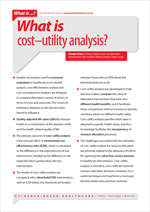What is cost-utility analysis?
Author: Christopher McCabe
Analytic techniques used for economic evaluation in healthcare (cost–benefit analysis, cost-effectiveness analysis and cost–consequences analysis) are designed to compare alternative courses of action, in terms of costs and outcomes. The choice of technique depends on the decision they intend to influence.
Quality-adjusted life-years (QALYs) measure health as a combination of the duration of life and the health-related quality of life.
The primary outcome of cost–utility analysis is the cost per QALY, or incremental cost-effectiveness ratio (ICER), which is calculated as the difference in the expected cost of two interventions, divided by the difference in the expected QALYs produced by the two interventions.
The results of cost–utility analysis are compared with a threshold ICER; interventions with an ICER below this threshold are funded, whereas those with an ICER above the threshold tend not to be.
Cost-utility analysis was developed to help decision-makers compare the value of alternative interventions that have very different health benefits, and it facilitates these comparisons without recourse to placing monetary values on different health states. Cost–utility analysis specifies what value is attached to specific health states, and thus increasingly facilitates the transparency of resource allocation processes.
The challenges associated with the utilisation of cost–utility analysis for resource allocation are primarily related to the adequacy of QALYs for capturing the value that society attaches to healthcare interventions. Cost–utility analysis is, therefore, not a sufficient basis for resource allocation decisions; however, it is a useful technique and it performs a necessary function better than previous methods.
